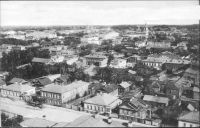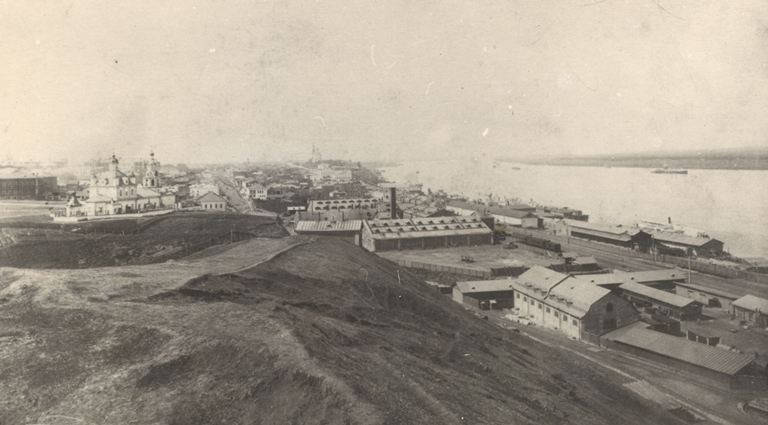History at a glance

The name of the city
There are several viewpoints on the origin of the name of Perm. The name is believed to be related to the word “parma” which originated in the language of the Komi-Permyak tribes and meant a hill covered with thick forest. Although the city of Perm is, in fact, located on the hills formerly covered by thick pine tree forests, it is hardly possible to take “parma” as the city’s name origin due to its phonetic features.
Another version attributes the name to a combination of the names of two tribes “em’ ” and “per” – living in the area of the Vychegda river.

Some theories link the name of the city to the legends, in particular, those featuring Pear, the Komi-Permyak folk hero. There is also a research which outlines the link between the name of “perm’ to a land of Biarmia; the latter is referred to in the ancient Scandinavian sagas as a land located in the east of Scandinavia where the Vikings used to travel for firs and silver.
In fact, the word “perm” was for the first time mentioned in the12thcentury record, which listed different tribes of the area. Modern toponymic studies believe that the word “peramaa” («the faraway land”) meant the territory populated by ancestors of the modern Komi-Zyryans and the Komi-Permyaks; it further transformed into “perm” and began to mean both the tribes and the lands where they settled in the Upper Kama area. The name hen began to refer to the whole territory of the modern Perm Region; in the 18thcentury it was used as the name of the province and finally – of its centre, the city of Perm.

The emergence of the city.
The history of Perm city is traditionally connected with the opening of the Yegoshikha metal-smelting works in 1723. The first mentioning of a “pochinok”, i.e. a new settling, “on the Kama river, on the Yegoshikha river” one can find in the records dating back to 1647 and 1678.
Captain Vassily Tatischev, the mining supervisor, is regarded as the founder of Perm city as it was he who chose the area around the Yegoshikha river as location for a new state-run plant. Tatischev was then called back to St.Petersburg in 1721 and was replaced by the artillery Major-General Wilhelm de Genin.
The construction of the Yegoshikha copper-smelting works completed between May 1723 and January 1724. A 56- meter long dam, 6 smelting ovens, ore and coal stores and other buildings were erected. By 1723 the settlement had 112 households listing 302 male population.
 After Wilhelm de Genin left for St.Petersburg in 1734, the Perm Mining Department was moved from the metal works in Pyskor to Yegoshikha. The new management started two new schools in the settlement, those of Arithmetic and Literature, which trained the staff for the state works, and a hospital. In1735 the roads to Solikamsk and Okhansk were built, and a few years later the foundation of the Siberian Road was laid. This enhanced the administrative and cultural importance of the works itself and the settlement.
After Wilhelm de Genin left for St.Petersburg in 1734, the Perm Mining Department was moved from the metal works in Pyskor to Yegoshikha. The new management started two new schools in the settlement, those of Arithmetic and Literature, which trained the staff for the state works, and a hospital. In1735 the roads to Solikamsk and Okhansk were built, and a few years later the foundation of the Siberian Road was laid. This enhanced the administrative and cultural importance of the works itself and the settlement.
In 1757-1764 the first stone buildings were erected – St.Peter and Paul Church and St.Catherine side-chapel, the office, the manager’s house and the guardhouse.
After the peasants uprising of 1773-1775 the tzar government took measures to break the large-scale provinces into a smaller units. Thus, to spot the location suitable for the center of the future Perm Province, two commissions were sent to the Kama area, headed by Governor-general of Kazan Prince Platon Meschersky and the Governor of Vyborg general Evgeny Kashkin respectively. Both commissions were unanimous in choosing Yegoshukha as the best location for the new province center.
_mal.jpg)
On November 20, 1780 Empress Catherine II sent a decree to general Kashkin appointing him the Governor of Perm and Tobolsk, as well as establishing the area of Perm including two provinces – those of Perm and Tobolsk - under his rule, and approving the new city of Perm as its center.
In1788 the works at Yegoshikha were closed down due to the lack of ore supply, and in 1804 «the works and its lands were handed over to the benefit of Perm City». Only the “Zavodskaya Square “ (“the Works’ Square”) near the Yegoshikha river reminded the residents of the former plant; this was further replaced by the name “Razgulyaj” in the end of the 19th century.
The first design plan for the city was made by the local surveyor Andrey Gruber in 1782-84. The plan quite obviously retained the features of the original settlement which gave birth to rectangular planning of the modern Perm streets.
Interesting Facts about Perm
- The first post stamps in the Soviet Russia were printed in Perm
- Perm stretches along both banks of the Kama River for over 70 kilometers and boasts the third place in Russia in terms of length after St Petersburg and Volgograd.
- Perm has 6 twin cities worldwide.
- Perm ranks fourth in Russia in terms of the area.
- The world’s largest 20-inch cannon is located in Perm.
- Perm was the junction at the first railways in the Urals.
- Perm City administratively is divided into 7 districts: Dzerzhinky, Industrialny, Kirovsky, Leninsky, Motovilikhinsky, Ordzhonikidzevsky, Sverdlovsky.
- At the time of World Wide II Perm became the home for 64 enterprises evacuated from the central cities, as a result, the population of the city of the time grew nearly twice.
- Alexander Popov, the inventor of radio, was a graduate of Perm Theological School.
- Russian painter Pyotr Vereschagin (1842—1904) was born in Perm.
- Vassily Tatishchev, a public figure, scientist and mining engineer, is considered to be the founder of Perm City.
- Evgenia Serebryannikova has become known in history as a public figure and the first female ophthalmologist. In 1886 she initiated the establishing and then headed the ophthalmology department in the Perm province hospital, which was the first regional ophthalmology clinics in Russia.
- Sergey Diaghilev is known to have lived in many cities, however, his personality and zeal for arts to a great extent developed in Perm – in his grandfather’s house located on the corner of the Big Yamskaya and Sibirskaya Streets (the mansion is now housing School No 11). The Diaghilev Seasons festival is traditionally held in Perm every year.
- According to the survey held by Yandex as of 04.10.2017:
The longest street in Russia is the street located in Perm called Vostochny Obhod (The Eastern Bypass): it is 22.6 kilometers long.
There are 1414 streets in Perm, and 1408 street names.
Total length of all the streets in Perm makes 1,200 km.
The shortest street in Perm – Kalinovaya– is only 44 metres long.